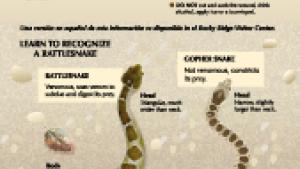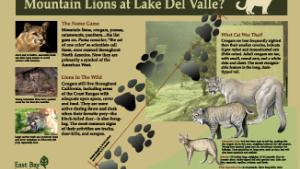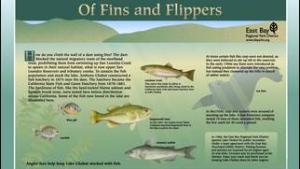The abundant and diverse assortment of birds, mammals, reptiles, and invertebrates that dwell in the regional parks is an integral part of the ecology of the San Francisco Bay Area and an aesthetic natural feature of the parks that visitors greatly enjoy. The terrestrial wildlife found within the parks occupies a variety of habitats. Most species are native and adapted to the California landscape and climate. The District manages animals that are not native to the region or are feral (domestic animals that have returned to a wild, untamed condition) to minimize conflicts with native species. The District is responsible for the protection of all wildlife, including animals that are state and federally listed as rare, threatened, and/or endangered, and others that are of local concern. Certain additional species, whose specific habitat requirements limit their population size and distribution, may require special management to reduce the potential for isolation or loss of the population.
Visit the Biodiversity Protection page to learn how the District protects wildlife.
Policies
Visit the Biodiversity Protection page to learn more about Domestic Cats in East Bay Parks.
- Free-Roaming Cat Management (PDF), Adopted June15, 2021
- Cat Policy - Board Meeting Presentation (PDF), June 15, 2021
- Cat Policy - Staff Report (PDF), June 2021
- Wildland Management Policies (PDF)
Posters & Brochures
Interpretive Wildlife Brochures
- Wildlife Protections And Free Ranging Cats (PDF)
- California Mountain Lions [2018] (1 pg)
- Life of the Mountain Lion [2018] (1 pg)
- Bat Distribution and Abundance in the East Bay Regional Park District [2018] (1 pg)
- Western Snowy Plover Macro-Invertebrate Prey Availability at Robert Crown Memorial State Beach [2018] (1 pg)
- Diet Trends and Nesting Success of Two Sympatric Terns Breeding in the San Francisco Bay [2018] (1 pg)
- Western Snowy Plover Nest Site Selection & Oyster Shell Enhancement -TWS Conference [2015] (1pg)
- Alameda Creek Riparian Bird Community Occupancy Analyses [2013] (1 pg)
- Control of Invasive Exotic Chamomile and Its Effects on Nesting California Least Terns [2013] (1pg)
- California Gull Predator Management and Reproductive Success of Endangered California Least Terns in the San Francisco Bay, CA [2012] (1pg)
- Movement Patterns and Habitat Use by the Western Pond Turtle (Actinemys marmorata) in the East Bay Regional Park District [2012] (1pg)
- Breeding Status and Diet Trends of Two California Least Tern Colonies in The San Francisco Bay [2011] (1pg)
- Western and Clarks Grebe Nest Platforms Designed for Fluctuating Water Levels [2009] (1pg)
Protecting Wildlife
The District is committed to protecting endangered wildlife and is especially concerned about four shoreline species: the California least tern, California Ridgway’s rails, western snowy plovers, and salt marsh harvest mice. If these birds and mice were widespread and common, we wouldn’t be as worried, but these species have lost about 95% of their tidal wetland habitat and are all listed as either threatened or endangered under the Endangered Species Act.
Sometimes well-meaning park visitors believe they are giving an animal an opportunity for living a good life, but the reality is that domestic animals and pets released in the parks cannot fend for themselves and often starve, fall victim to diseases, or become prey to larger animals. In addition, introduced domestic animals often compete with native animals and cause disruptions in the food web.
Visit the Biodiversity Protection page to learn how the District protects wildlife.
Domestic Cats in East Bay Parks (PDF)
Animal Shelters
The East Bay Regional Park District is working with local animal shelters throughout the East Bay to safely relocate and rehome free-roaming domestic cats found in parks. Below is a list of shelters near you:
Contra Costa County Animal Services
East County Animal Shelter and Field Services
Fremont Animal Services / Tri-City Animal Shelter
Friends of Alameda Animal Shelter (FAAS)
East Bay SPCA - San Leandro Animal Services
Publications and Reports
- NatureCheck Creates Baseline for Measuring the Health of Wildlife in the East Bay [2022].
- Dogs detect larger wind energy effects on bats and birds. Journal of Wildlife Management [1–13; 2020; DOI: 10.1002/jwmg.21863]
- Relating bat passage rates to wind turbine fatalities. Diversity [2020, 12, 84; doi:10.3390/d12020084]
- Effects of wind turbine curtailment on bird and bat fatalities. Journal of Wildlife Management [1–12; 2020; DOI: 10.1002/jwmg.21844]
- Skilled Dog Detections of Bat and Small Bird Carcasses in Wind Turbine Fatality Monitoring [2019] (pp. 32)
- Relating Bat and Bird Passage Rates to Wind Turbine Collision Fatalities [2019] (pp. 21)
- Effects of Wind Turbine Curtailment on Bird and Bat Fatalities [2019] (pp. 24)
- Bald Eagle Nesting Trends & Disturbance Sources in the EBRPD [2019] (1 pg.)
- New insights into the phylogenetics and population structure of the prairie falcon (Falco mexicanus) [2018] (14 pp.)
- Bald Eagle Management in Urban Wildfire Hazard Reduction Wildlife Society Eagle [2013] (1 pg)
- Monitoring Trends in a Breeding Bird Assemblage Implications for Riparian Conservation [2010] (1 pg)
- Birds of Prey Remain at Risk - Science Magazine [2010] (2pp)
- Range Management Practices to Reduce Wind Turbine Impacts on Burrowing Owls and Other Raptors in the Altamont Pass Wind Resource Area, California [2009] (298 pp)
- Map-Based Repowering and Reorganization of a Wind Resource Area to Minimize Burrowing Owl and Other Bird Fatalities - Energies [2009] (29pg)
- The Status of the California Tiger Salamander (Ambystoma californiense), California Red-Legged Frog (Rana draytonii), Foothill Yellow-Legged Frog (Rana boylii), and other Aquatic Herpetofauna in the East Bay Regional Park District, California [2007] (87pp)
Videos

How can you help wildlife?
Links
U.S. Fish & Wildlife Service (Sacramento Office)
An agency for conserving and protecting the natural habitats of fish, wildlife, and plants in the state of California
Department of Fish and Wildlife
Link to the state of California's Fish and Wildlife website
California Native Plant Society
A group and advocate for conserving California's native plants

















